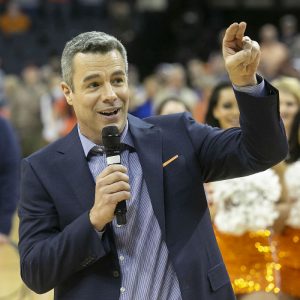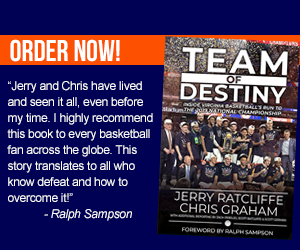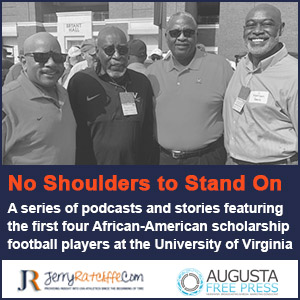Catching Up With Coach Tony Bennett
By Jerry Ratcliffe
 A lot has transpired in the two-plus months since Tony Bennett cut down the national championship net in Minneapolis.
A lot has transpired in the two-plus months since Tony Bennett cut down the national championship net in Minneapolis.
Virginia’s coach has dealt with the loss of five players — one who graduated, one who transferred, and three who took early exits for the NBA Draft. He has been busy talking to NBA personnel about those three players, and one other who has since withdrawn from the draft.
In the aftermath of those departures, Bennett has also been tied up with recruiting and roster management. He was part of UVA’s rubber-chicken circuit where he and other coaches join AD Carla Williams on the VAF booster club tour for meet-and-greets. If that wasn’t enough, he met with his new team this week for the first official day of summer workouts.
So you’re probably wondering, does this guy ever get a day off?
For sure, though college sports have all now become year-round jobs.
Last month, Bennett and his dad, Dick, both golfers, were treated to a dream round at Augusta National, home of The Masters.
“To experience what I did with my father was absolutely amazing, a highlight,” Bennett said this week.
When pressed about sharing his score at the challenging Augusta layout, Bennett was a little evasive, which was not surprising. Not only is the Virginia coach a very private man, he’s particularly private about his golf, one of his passions away from basketball.
“Nine or 10 under par,” Bennett chuckled. “A few good shots and a few bad shots. More bad putts than good putts.”
It was a couple of days of downtime and pleasure for Bennett to decompress. After all the stress and demands and pressure of guiding a team with high expectations to Virginia’s third Final Four and first national championship, it was certainly a well-deserved trip to Georgia.
For media, it was the first opportunity to talk to Bennett since the national championship celebration at Scott Stadium back in April. It was likely the last contact media will have with him until October. We told you he was a private man.
There really wasn’t a lot of news to come out of this week’s briefing other than Tomas Woldentensae, the first junior-college recruit during Bennett’s decade at the helm, is recovering from a similar wrist injury to De’Andre Hunter and Kihei Clark’s, and is just now being cleared by doctors to get back to work.
Perhaps the other bit of news was that while UVA has one scholarship remaining for this present class of 2019, it likely won’t be used to add another player to this fall’s roster, although as Bennett said, all options are on the table in these modern times of college basketball.
“Tomas missed the end of his year with a wrist injury and he’s just getting cleared to do things with his left hand, his shooting hand, so that will be over the course of the summer as he begins to ease his way back into it,” Bennett said of the 6-foot-5 shooting guard.
“When I sensed we were going to lose a lot of our guys, we needed some help on the perimeter, so we scoured [the country]. I was given a great heads up (about Woldentensae) by a coaching friend of mine that was recruiting him, and he said, ‘Hey, here’s a guy you should take a look at.’ We just pursued it. The experience of someone who has been in the game could be helpful.”
Woldentensae was a junior college All-American and shot 47 percent from the 3-point line last season.
Speaking of the 3-point line, we had to ask Bennett, who still holds the NCAA record for career 3-point accuracy, his opinion of the new arc for college hoops.
“I’m not sure yet,” he said. “It’s currently 20 feet, 9 inches. It goes back about 17 inches at the top [of the key] and 11 inches in the corners. Sometimes it can separate some shooters. Some guys toe the line. They’re right there. Guys like Kyle and Ty, it wouldn’t have been an issue. It might separate some of the toe-the-line shooters.
“We’ll see does it open up the court more. The debate is what about the lane staying the same and not widening it. When they did it a few years ago, for a year or so it dropped percentages, then caught back up. I don’t think it will change what we do dramatically. But a lot of guys shoot the deep ball from NBA three [range].”
The new 3-point line will be the identical distance of the international basketball line, 22 feet, 1¾ inches. The NBA line ranges from 22 feet in the corners to 23 feet, 9 inches to the top of the key.
According to the NCAA, the purpose of the new distance for college basketball is to clear the lane for more drives to the basket and to make the 3-point shot more of a challenge.
Bennett was correct about percentages dropping the last time it was moved, and in the most recent experiment, when the NIT moved the 3-point line back for its last two tournaments, teams combined to shoot 33 percent, 2.2 percent overall less than average.
Bennett wasn’t so sure what to think of a new rule that will reset the shot clock to 20 seconds after an offensive rebound (the NBA rule is 14 seconds), but did like the rule that will now allow coaches to call a live ball timeout in the last two minutes and in overtime.
In terms of scholarships, Bennett said that most [recruiting] for this class has closed down around the country, but left the door open.
“It’s such a different time with grad transfers and other opportunities,” Bennett said. “The [recruiting] pool is shrinking (for this class), but you just never know. Things change week-to-week, and hey, if there’s a guy available. We’re focusing more on the class of 2020 and 2021.”
The most drama of the NBA Draft exodus was redshirt senior Mamadi Diakite, who declared, hired an agent, attended G-League Elite Camp, did not perform well and was not invited to the NBA Combine. He worked out for some teams but in the end decided to return to UVA for his final year of eligibility, which new NCAA rules allow.
“If you can knock it out of the park and people feel there’s an opportunity, then you have to consider that,” Bennett said about Diakite and others. “If not, grow from the experience, learn from it, take what you did, come back and be a part of this, improve your game, get your degree, and be prepared as much as you can next year. I was there for [Diakite] and wanted what was best for Mamadi, for him to get the feedback and make a sound decision.”
Bennett said that he and Diakite exchanged text messages during the process, but for all of his players, he just wanted what was best for each of them.
It was interesting to Bennett that the NBA folks did their homework. He said GMs and player personnel folks would call him after some Virginia players worked out, and some of them even showed up at JPJ to interview everyone from academic coordinators to trainers in order to learn as much as they could about players they potentially might draft.
“I text our guys and pray for them and encourage them and tell them to keep working,” Bennett said.
While those guys were exiting, more were coming in to replace them. Did winning the natty influence recruiting?
“It has built some things from before and hopefully strengthened us from certain positions,” Bennett said. “It certainly can’t hurt, and I think it has helped. There’s excitement and validates a lot of good stuff that’s happened in the past.”
With Hunter, Kyle Guy, and Ty Jerome leaving for the NBA, and Jack Salt graduating, and Marco Anthony transferring to Utah State, Bennett greeted his new team this week on the first day of summer school. The coach sees it as an opportunity for all the newcomers, particularly those in the backcourt, which lacks proven depth.
“Our front court, 4s and 5s, is strong. The perimeter, well, there will be some opportunities out there. There’s always a learning curve and there’s no substitute for experience,” Bennett said.
UVA’s system isn’t that complicated, the coach explained, it is more about going up a level and playing in the ACC, where there’s a challenge of physicality, talent and the speed of the game.
“It’s not like you have to memorize 500 plays,” Bennett said. “It’s the discipline and the habits of being in the right spots defensively. The complicated part is doing it over and over with efficiency. That’s where the challenge comes.”








